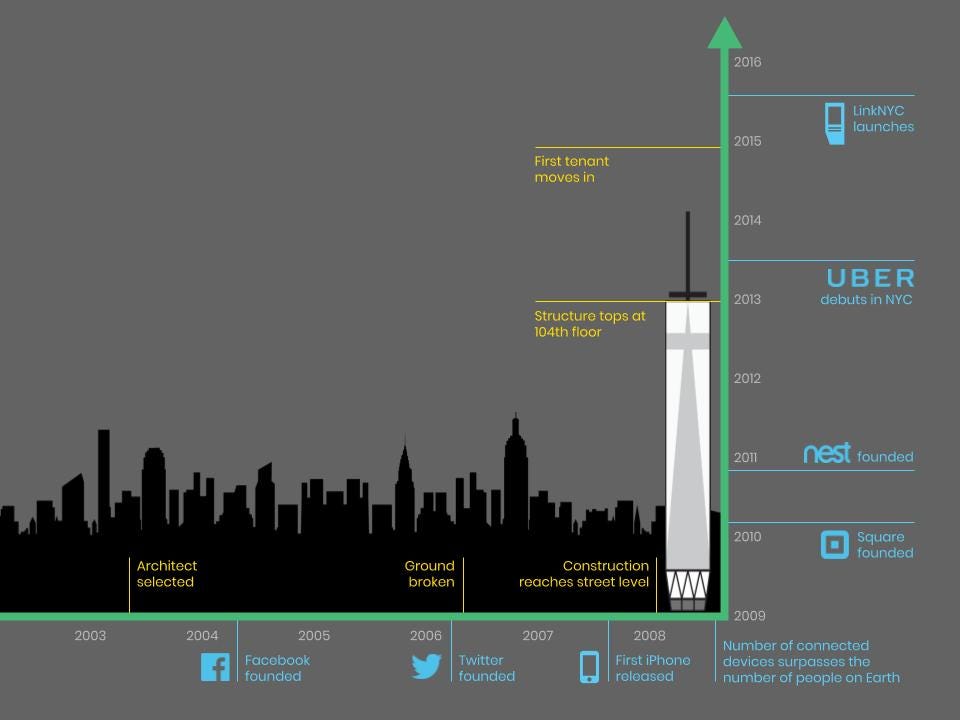https://ixn.intersection.com/building-a-city-like-a-smartphone-652876e2f2c7
Building a City like a Smartphone
The most predictable thing about technology is the pace of its change. From Moore’s Law to the annual release of new iPhones, we expect each year to bring new technologies and cost efficiencies. Yet when it comes to the buildings and infrastructure that make up our cities, too often we expect the opposite: lengthy delays and cost overruns.
During the design and construction of a single project, whole generations of digital evolution may take place. When design for One World Trade Center (1WTC) began in 2003, neither Facebook nor Uber existed, and Blackberry was the clear leader in smartphones.

During the second half of 1WTC’s construction, the Apple iPhone, released in 2007, saw at least 47 revisions to its operating system, changing how we communicate, shop, and experience media. By the time the first tenants occupied the building, people’s use of technology had evolved dramatically. At any point during the construction timeline, people’s current use of apps and devices wouldn’t have been a good guide to their future expectations.
When the digital and physical meet, some pieces move faster than others. How, then, do we create systems that won’t become obsolete in a matter of months or years? In other words, how can we build environments to be more like a smartphone that improves every year?
While technology and the way in which we interact with this technology is constantly shifting, there are certain fundamental components that remain constant. To bridge the difference in timescales and pace of change between larger systems — like buildings, neighborhoods and cities — and smaller systems, like iPhones and apps, there are three principles that can help ensure sustained relevance through the years.
Be Foundational: Rather than think of technology as a shrink-wrapped product, look to build the technical and human capabilities. Invest in the underlying infrastructure that will support the things you want to do. The base layer doesn’t change as quickly as the top layer. If you get the foundation wrong, it’s much harder to fix later. The diameter and location of 19th century conduit underneath New York City’s streets, for example, constrains where 21st century connectivity can go.
Be Modular: Instead of thinking in terms of units, think in terms of platforms. A streetlight must provide light, but it also offers a physical platform on the street — a place where power, space, and connectivity come together. Designs featuring easily exchangeable components enable new possibilities within the same basic infrastructure, from 5G broadband radios to chargers for electric vehicles.
Be Open: Innovation online has thrived in part due to an openness to collaboration with others. Application Programming Interfaces (APIs) and Software Development Kits (SDKs) allow anyone to build upon existing technologies, from sending mobile payments using Venmo to finding bikeshare locations on Google Maps. As people add smart home devices like programmable lighting and locks, standards like Z-Wave and Zigbee reduce the likelihood that homeowners will need to tear open their walls as new brands develop.
A smartphone hasn’t reached its full potential when the first model rolls off the assembly line. Through software updates and an open approach to innovation, its greatest value is created over time. Our goal for the built environment should be no less ambitious.
Applying these foundational, modular and open principles to our surroundings allows for flexibility, which in turn leads to sustainability and continued innovation. Such an approach makes it possible for buildings and cities themselves to benefit from the trends that enable continuous innovation in the digital world. While upgrading a building may never be as easy as downloading a software update, there’s a lot we can learn from comparing the two.
